Florida & Georgia
March 14-24, 2005
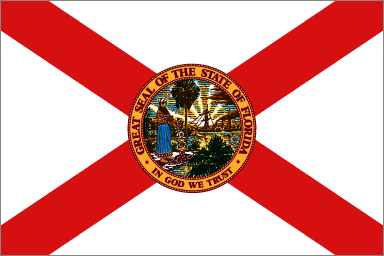
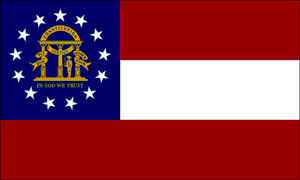
| Florida & Georgia March 14-24, 2005 |
 |
 |
![]()
We began this trip by flying from Sacramento to Key West, Florida with stops in Dallas and Miami. The Key West airport reminded me a little of the airports at Maui or Kauai in that you get off the plane, grab your bags, and are on the road in your rental car all in about 30 minutes. You can't do that at too many airports these days.
The next day, we drove all over Key West, first checking out Higgs and Smathers beaches (who says Key West doesn't have nice beaches?) and then seeing the southernmost house and hotel in the continental U.S. Of course we had our photo taken at the wacky-looking marker situated on the southernmost point only 90 miles from Cuba.
 Key West: Smathers Beach |
We then went to the Ernest Hemingway House and Museum. This house was built in 1851 by a rich shipping magnate named Asa Tift. Hemingway lived in the house from 1931 until 1940 when he moved to Cuba. We had a very animated guide who told us all kinds of great stories about Hemingway and his four wives. The house is located near the Key West lighthouse which Hemingway used to find his was home after a night of drinking at Sloppy Joe's Bar. The guide also pointed out a penny imbedded in the pool deck. The story goes that Hemingway's second wife Pauline Pfeiffer had a pool installed at a cost of $20,000 (the house was purchased for only $8,000) and when Hemingway found out about the pool, he took out the penny, gave it to Pauline and said to her, "You may as well take my last penny too". |
And then there are the cats. Hemingway was given a six-toed cat by a ship's captain and today, there are many descendants of that cat roaming freely in the house and on the grounds. There are about 70 cats and many of them have six toes. The cats are well cared for as a vet checks them once a week, there are food and water dishes everywhere and we even saw one cat sleeping on an antique couch with a "do not touch" sign on it.
From the Hemingway House, we located the most reasonable parking lot we could find - $10 for the whole day, and set out on foot. Our first stop was the Mel Fisher Maritime Museum. Mel Fisher was the treasure hunter who in the mid 1960s, vowed to find the wrecks of two Spanish war galleons, the Nuestra Señora de Atocha and the Santa Margarita lost along with six other ships and 550 people in a hurricane in the Straits of Florida on September 5, 1622.
Finally, in 1971, after losing his son, daughter-in-law and a crew member's son to boating accidents, and spending a huge amount of money, Fisher found the Atocha. He also found the Santa Margarita and salvaged $20 million in gold and silver from it. In 1985 Fisher and his crew were able to bring up the remaining treasures from the Atocha worth an estimated $4 billion.
To me the most fascinating items found were the incredibly crafted gold chains. I remember seeing Mel Fisher wearing a huge chain around his neck when he came on Johnny Carson's Tonight Show years ago. The links of these chains could be removed and used to pay for goods. In the gift shop, the counter person let me hold a chain that had a price of $160,000.
Mel Fisher has since passed on but the search for more treasures from these ships as well as hundreds of other ships that sank around Florida continues today and you can even invest (and participate) in the project and be rewarded with artifacts that are found.
The rest of our day in Key West was spent at Sloppy Joe's Bar, Capt. Tony's Saloon (the original Sloppy Joe's where Hemingway hung out) and watching the street artists perform at Mallory Square. We also watched the famous Key West sunset along with a thousand or so people who came in on a Royal Caribbean cruise ship.
The next morning we drove over the Seven Mile Bridge and through all the Keys (Marathon Key, Key Largo, etc.) to the Everglades National Park. Many people probably think the Everglades is all "swamp land" but it looks nothing like most of the swamps I have seen. The Everglades is actually a 50-mile wide shallow river slowly moving south from Lake Okeechobee. The highest elevation of the Everglades is 8 feet above sea level. In addition to the river which is now controlled by man-made means, there are hundreds of raised areas called hammocks, sawgrass prairies, pine forests, hardwood trees, royal palm trees, gumbo limbo trees, cypress swamps and the mangrove coast. There is an incredible amount of wildlife there and bird watching is exceptional.
|
The first trail we walked on was the best. It is called Anhinga Trail named after the Anhinga birds that nest there. We saw turtles, herons, egrets, wood storks, several different fish about 30 alligators there. Some of the alligators were resting only a few feet off of the trail. In other parts of the park, we saw dolphins, southern bald eagles, ospreys, hawks, deer, and more alligators. |
 Everglades National Park: Hitchin' a Ride |
After spending the night in Homestead (at a very "interesting" motel), we saw more of the Everglades and then stopped at Big Cypress National Preserve. We saw more alligators there and hiked on part of the Florida Trail through a cypress forest.
We spent that night in Naples and then drove through Fort Myers and up the west coast to Bradenton where saw the DeSoto National Memorial. The memorial commemorates the first major European exploration of the south eastern United States. Hernando de Soto and about 600 Spanish soldiers landed in the Tamp Bay area in 1539 and the expedition covered 4,000 miles in four years. There were many battles with Native Americans along the way. Only about half of the expedition survived to return to Mexico. DeSoto died from fever during the expedition and was buried in the Mississippi River. Many native people died as result of battles or diseases brought by the Spaniards. This site memorializes both the Native Americans and Spanish explorers.
From DeSoto National Memorial, we crossed Tampa Bay on the Sunshine Skyway Bridge to Tampa where we spent the night and the next day, we saw the Salvador Dali museum in St. Petersburg. This museum houses one of the world's largest collections of Dali oil paintings, watercolors, drawings and prints. The collection was assembled over 40 years by a rich Ohio industrialist, A. Reynolds Morse, and his wife.
We then drove across Florida to the Orlando area and Winter Springs where we visited a friend of mine and his family. I have known Peter since we were stationed together in Germany in 1975 and we cross paths every few years. Several years ago, we met up in Madrid for a tour of Spain, Portugal and Morocco.
The next day, we made the short drive to Daytona Beach for the "Great American Race" - the Daytona 500 NASCAR race. Before the race, we had a little time so we drove on the beach - Daytona is one of the few beaches where you can do that. There were only a few cars on the beach but I can imagine during Spring Break, this would be the ultimate car cruise with the cars probably lined up bumper-to-bumper.
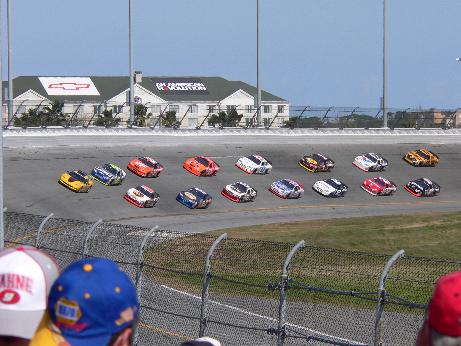 Daytona 500: Start of Race with Pace Car |
The Daytona 500 is the first race of the NASCAR season and it is the most famous. We bought our tickets online nine months earlier before they sold out. There were 250,000 people there! Kathy is more of a NASCAR fan than me and you can see everything way better on TV but I have to admit that the first time the cars went past us at about 185 MPH (we were only 13 rows up from the track), hearing the roar and smelling the exhaust was pretty exciting. There were four crashes and three of them occurred coming out of turn four right near us including one car that flipped several times. Fortunately, there were no serious injuries. This is where NASCAR legend Dale Earnhardt died in a crash in 2001. |
In addition to the top NASCAR race, I have seen the most famous Formula One race - the Grand Prix of Monaco, an NHRA (National Hot Rod Association) drag race event and a CART (Championship Auto Racing Teams) race - the Marlboro 500 in Fontana, California. I haven't seen an IRL (Indy Racing League) race so I hope to see the Indianapolis 500 someday. I actually drove a lap around the Indianapolis Brickyard track but unfortunately, it was in a bus.
After the race we spent the night back in the Orlando area and the next day headed to Cape Canaveral and the Kennedy Space Center (KSC). It would take two days (and over $70.00 per person for tickets) to see everything there but Kathy had already been there and I was mostly interested in the launch site complex so we opted for the basic tour and attractions. The bus tour took us by the Vehicle Assembly Building (VAB), the Headquarters Building, the Operations & Checkout Building, the Launch Control Center, the Space Station Processing Facility and the three hangars that make up the Orbiter Processor Facility (where they inspect and prepare the Space Shuttles). The tour stops at the Apollo/Saturn V center where a Saturn V rocket is on display and a 60-foot tall observation gantry where you have a 360 degree view of the Launch Complex 39. LC 39 includes the crawlerway that the Shuttle is transported on at 1MPH and Launch Pads 39A and 39B where the Saturn V rockets launched from and now the Space shuttles are launched from.
|
The VAB is one of the largest buildings in the world. It is 525 feet tall, covers eight acres and encloses a volume of 3.6 million cubic meters. It was originally designed to support the stacking of four Saturn V moon rockets at the same time and is now used to assemble the Space Shuttle. Back at the visitors center, we saw a full-scale Space Shuttle replica, the "Rocket Garden", the Space Mirror (Astronaut Memorial), many exhibits, and a talk by Shuttle astronaut John Blaha. There was way more there than we had time to see including two Imax theaters, the U.S. Astronaut Hall of Fame, several shows and exhibits and optional tours of the older active and historic launch pads located on Cape Canaveral Air Force Station. |
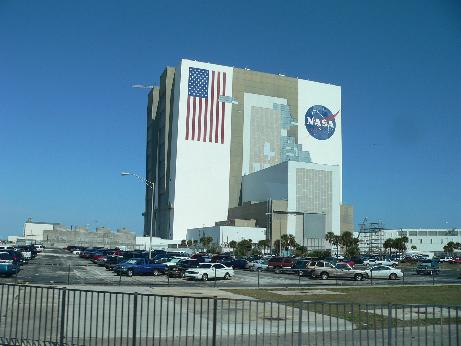 Kennedy Space Center: Vehicle Assembly Building |
After spending the night in St. Augustine, we backtracked about 15 miles south to see Fort Matanzas National Monument. Fort Matanzas was a small Spanish fort built in 1740-42 on Rattlesnake Island. It was built to defend against a British attack on St. Augustine from the Matanzas River. You have to take a short boat ride to get to the Fort which is made of coquina, a local shellstone which absorbs the impact of artillery shells quite well.
After visiting Fort Matanzas, we drove back to St. Augustine, founded in 1565 and the oldest continuously occupied European settlement in the United States. Juan Ponce de León landed in this area on April 3, 1513 during his search for the Fountain of Youth.
We entered the city by crossing the Bridge of Lions and headed for our first stop, the Castillo de San Marcos National Monument. Castillo de San Marcos is a fortress built by the Spanish in 1672-1695. It replaced nine successive wooden fortifications that had protected St. Augustine since its founding. It is the oldest masonry fort and the best preserved example of a Spanish colonial fortification in the continental United States. The symmetrical fort has massive diamond-shaped bastions at each of its four corners, and 60 to 77 cannons once occupied its gun deck. Like Fort Matanzas it was built using coquina. The fort was used by the Spanish, the British and the Americans throughout its history.
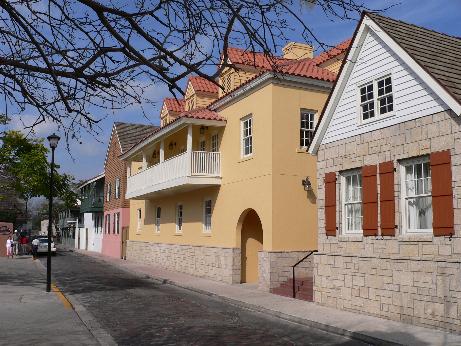 St. Augustine |
We drove and walked around St. Augustine seeing the oldest Spanish Colonial house built in the early 1700s on a site occupied since the early 1600s, the oldest wooden schoolhouse (1750-60), the Colonial Spanish Quarter, the lighthouse, the Mission of Nombre de Dios and many other historic houses located on George Street. The town of St. Augustine is quite picturesque but I would have to say the Castillo de San Marcos was my favorite place that we visited there. |
By the start of the Civil War in 1861, Fort Pulaski had not yet been garrisoned and the Governor of Georgia, Joseph E. Brown ordered the State militia to seize the fort. This meant that before the United States could occupy the fort, they had to conquer it.
|
Most people considered the fort's 7½ foot solid brick walls backed with massive masonry piers unbreachable. That theory was proven wrong when the Union forces began bombarding the fort from 11 batteries, some of which were located up to a mile from the fort. What finally breached the walls forcing the fort's commander Col. Charles H. Olmstead to surrender on April 11, 1862 was 30 hours of bombardment from Union artillery including 10 newly developed and still experimental rifled cannons. These cannons had an effective range of 8,453 yards using bullet shaped shells. The breached area of the fort was repaired after the Union troops occupied it, but today you can still see many shells embedded in other areas of the fort's walls from that bombardment. |
 Ft. Pulaski: Artillery Damage and Rebuilt Breached Area |
 Savannah: Mercer House |
The next day, we left Savannah and headed back to Jacksonville Florida to catch our late afternoon flight. But wait! Jacksonville was only about 100 miles away and we still had several hours of free time so we stopped near the town of Brunswick, Georgia to see the Hofwyl Broadfield Plantation State Historic Park. The Hofwyl Broadfield Plantation was a rice plantation. The house that we toured was built in the 1850's and throughout the plantation, there are beautiful huge oak trees draped in Spanish moss, some as much as 800 years old. |
|
The weather was perfect - except for the very last day
when it rained, it was sunny and in the mid to high 70s. I would say this has
to be the best time to visit this area. I imagine seeing the Everglades in the
summer would be pretty miserable because of the heat, humidity and
mosquitoes. Except for Epcot, I had no desire to see the huge Disney/MGM complex and Universal theme parks in the Orlando area. Kathy had been to Disney World and Universal Studios before so it was easy for us to pass up these places which would probably require another week to see. Otherwise, I think we got a pretty good tour of what Florida and the coast of Georgia have to offer and would highly recommend this area to anyone with an interest in history, beaches, flora, fauna, space exploration, sunken treasure, art or watching cars go round and round at up to 200 MPH. |
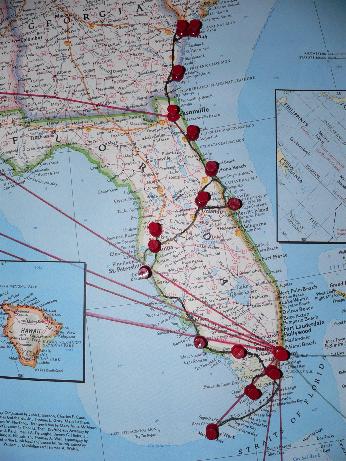 Trip Route With Stops |